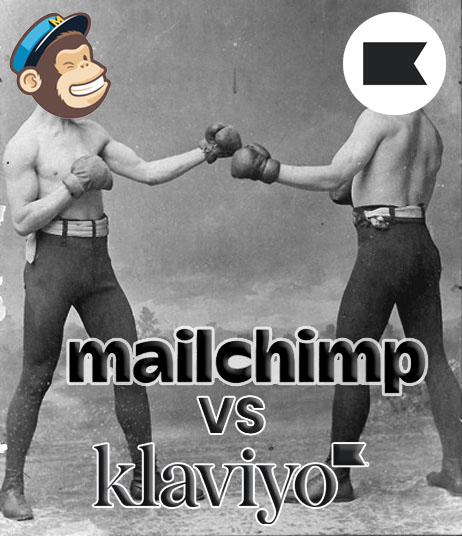
Is your ecommerce brand looking to maximize revenue from email but you aren’t sure which service is better in the Klaviyo vs Mailchimp matchup?
Or, you’re an email marketer looking to help your clients make the decision with concrete bottom-line impacting examples?
Then this article was written for you.
The key to improving the conversion rate of your ecommerce site without constant ad spend is through email automations and campaigns.
But why should you listen to me?
I run my own ecom brand, email marketing agency, and have used both Mailchimp and Klaviyo. I’ve been ‘down in the weeds’ of both services.
Full disclosure: as an email marketer, I prefer Klaviyo, but my aim is to be fair and show you what each platform offers.
TLDR – just show me the conclusion!
We’ll review: Automations; A/B Testing, Segmentation and Data; Reporting and Analytics; SMS; Ease and Support; and pricing.
So let’s compare:
Klaviyo vs Mailchimp Automations
Email automations or sequences are called flows in Klaviyo and are also known as the customer journey in Mailchimp. I’ll be using the words automation, flow, sequence and customer journey interchangeably in this article.
Both brands offer great baseline pre-built automations for ecom brands. But Mailchimp’s automations fall short in sophistication. You simply have fewer options on the triggers, filters and data about your subscribers. This means that your emails will suffer in relevancy and timeliness.
Klaviyo has excellent filtering options. If a customer triggers a flow multiple times, you can create filters so that they aren’t bombarded with annoying duplicate emails.
In an abandoned cart event, potential customers may trigger this flow more than once over the course of a few days as they window shop or find their correct credit card. If you use Mailchimp, your prospective buyer would receive the same duplicate sequence of emails each time.
This by itself can turn would-be buyers into un-subscribers. If you were using Klaviyo, you can limit the number of times that a flow will fire-off for the same user over a period of time.
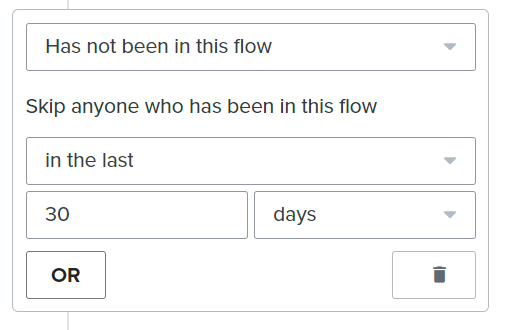
Klaviyo also has a catch-all filter, Smart Send, where you can limit subscribers to only receive 1 email every 16 hours.
Another big flaw is that Mailchimp doesn’t have the native ability to send browse abandonment email flows. This is where a subscriber browses some products but doesn’t start checkout and doesn’t buy.
With Klaviyo, you know exactly what product they browsed. This let’s you send an automated email with more information about that specific product to help seal the deal.
How does this impact your business?
Klaviyo is the clear winner here. You will be able to send more relevant flows to the right people which will increase conversions and sales. You’ll get fewer unsubscribes and lost sales from spamming with duplicate emails.
A well-tuned browse abandonment flow can be worth thousands of dollars per month based on the size of your business and this is only available with Klaviyo.
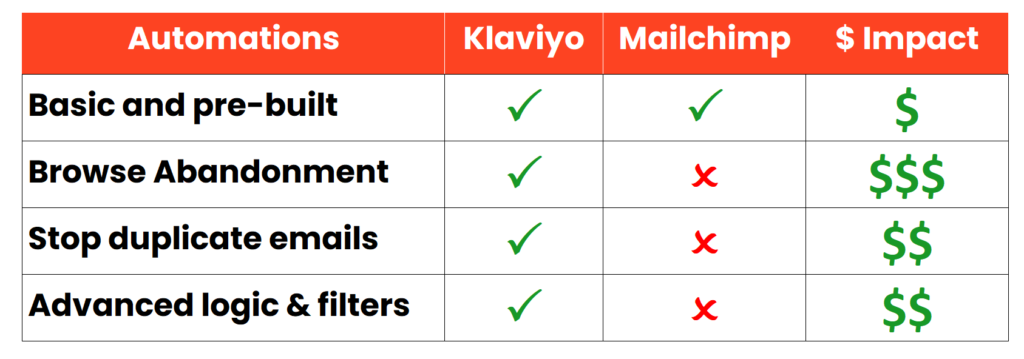
A/B Testing
The Klaviyo vs Mailchimp matchup has gotten much closer here.
Both Mailchimp and Klaviyo allows out of the box A/B testing for campaigns and automations as of 2022. For many years, Mailchimp did not have the functionality to A/B test automations. Klaviyo allows for A/B testing of sign-up forms which is significant, which isn’t available in Mailchimp.
Mailchimp A/B testing for campaigns is similar to Klaviyo, but for automations it’s more cumbersome. You need to split the entire automation 50/50 and then manually track the results. This can make flows look really big visually.

Klaviyo makes A/B testing automations straight forward and all within the same branch of events. This makes it easier to visualize and less work if you need to make changes to the sequence.

Klaviyo also has a feature where the winner of the test is automatically selected and made live after a set time or number of emails.

How does this impact your business?
Klaviyo wins out over Mailchimp with the added feature of A/B testing sign-up forms. A/B Testing sign-up forms like a first-order discount popup will improve their conversation rate and will convert more of your traffic into subscribers. More leads will receive your welcome series flow and convert into first-time buyers.
Klaviyo also has more user-friendly A/B tests for campaigns and automations. The main benefit here is you will save time by using Klaviyo. You won’t need to manually revisit each automation A/B test and select the winner. It will just happen.

Segmentation and Data
There’s no comparison here. Klaviyo integrates more data, more often from more sources compared to Mailchimp. You also can fine tune your segments to zero-in on your email marketing.
Want to send a campaign to customers who’ve bought product A in the past 6 months but haven’t bought product B but who also aren’t subscribe-and-save customers?
Or set up an automation to encourage a second-time customer of product C to sign-up for your refer-a-friend program?
You can segment your subscriber’s to your heart’s desire with Klaviyo.
Mailchimp uses tags and groups to segment your audience. They limit the number of criteria (5) you can use to create segments and has fewer options. Options are basic such as ‘recent purchasers’, ‘new subscribers’.
Mailchimp’s real gap here is not knowing how much and what specific products your customers have bought in the past. This is a critical detail when segmenting campaigns and flows. You don’t want to market maternity clothing to your male subscribers.
But you can also target subscribers based on whether or not they have received or opened specific campaign or automation emails, which is neat.
To unlock more advanced segmentation, you must pay for the premium plan.
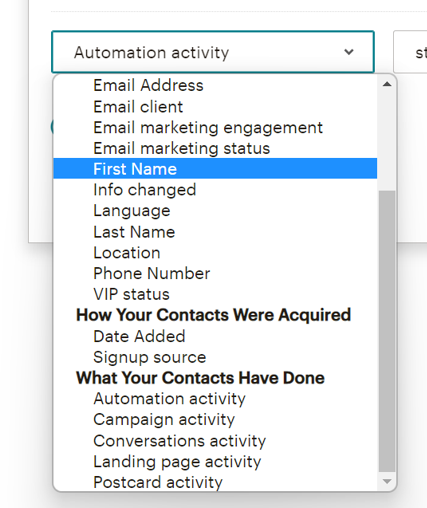
Klaviyo on the other hand uses real-time customer data. Seven minutes ago your subscriber opened the email campaign you sent yesterday. They clicked one of the links and are now browsing on your website on a specific product. You can see all of this data for specific customers, or using a dashboard.
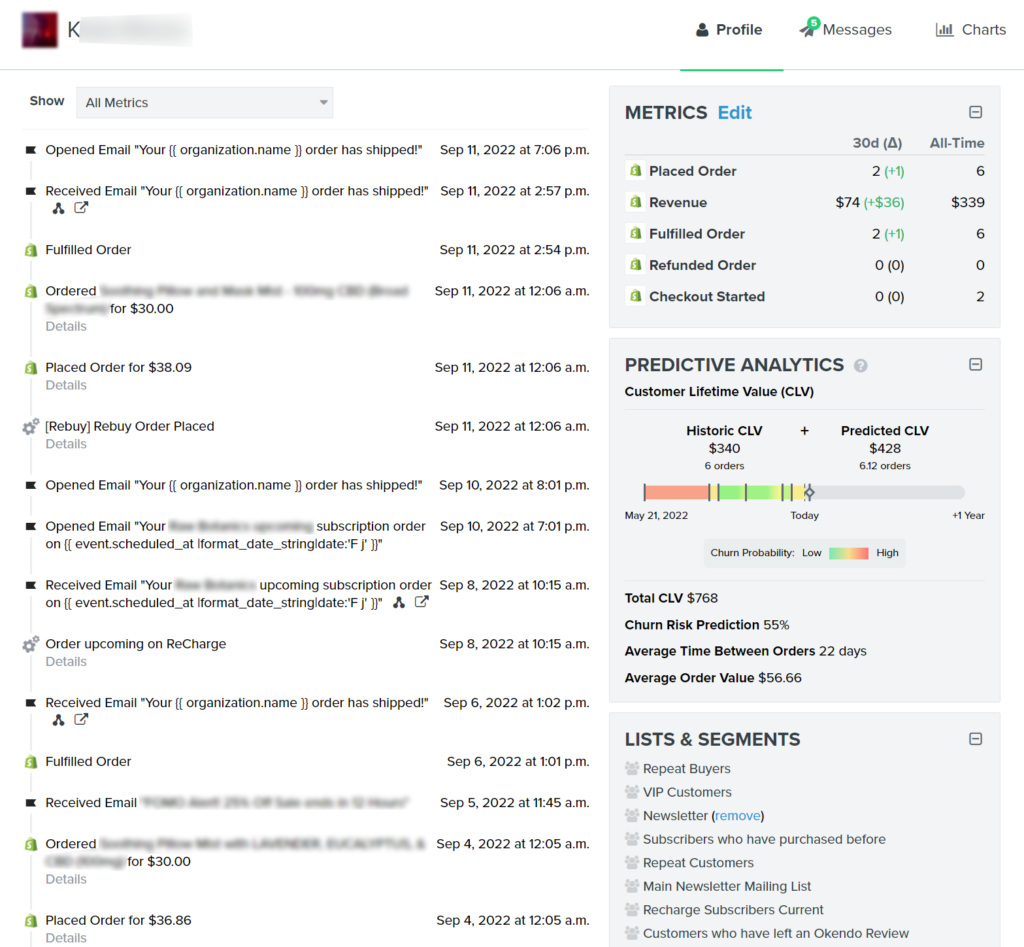
How does this impact your business?
Mailchimp’s lower level of data means that you need to be more generic in your emails. You don’t know what your recipient has purchased, if they are a VIP or their other behaviors. This leads to emails that are less relevant and increases the chance of duplicative or irrelevant content being sent to your subscribers.
Klaviyo’s data and segmentation capabilities are the clear winner. It allows you to create hyper-focused segmented emails that convert. This is important for brands that sell products under multiple product lines or sell gender specific products.
Klaviyo lets you send different welcome series based on where your subscribers signed up. Did they come from your Facebook campaign? Black Friday postcards? Or just website traffic? That data is relevant because your marketing should be a smooth transition from the last thing they saw from your brand.
Sending relevant emails will increase open rates and sales, sending irrelevant emails will lead to lower open rates, harmed sender reputation and more unsubscribes.
Klaviyo vs Mailchimp Reporting and Analytics
If data is king in the ecommerce business, reporting is queen.
Imagine this scenario:
Your recent campaign tanked and had less than 10% open rates. Normally you get 30%. You’re bummed. You think the problem was the graphics.
But after digging into the open rate report you find that open rates were almost zero for all gmail recipients. But were average for everyone else.
Noticing that anomaly you look into it further. Gmail had updated their spam filters on the day that your campaign went out.
So you fix the minor detail that was causing your email to get caught up in gmail ‘promotions’ purgatory.
Instead of going down the rabbit hole spending time re-working graphics that were fine
Analytics allow you to see what’s working and do more of that and less of what’s not.
Reporting shows you how you are performing at a high level.
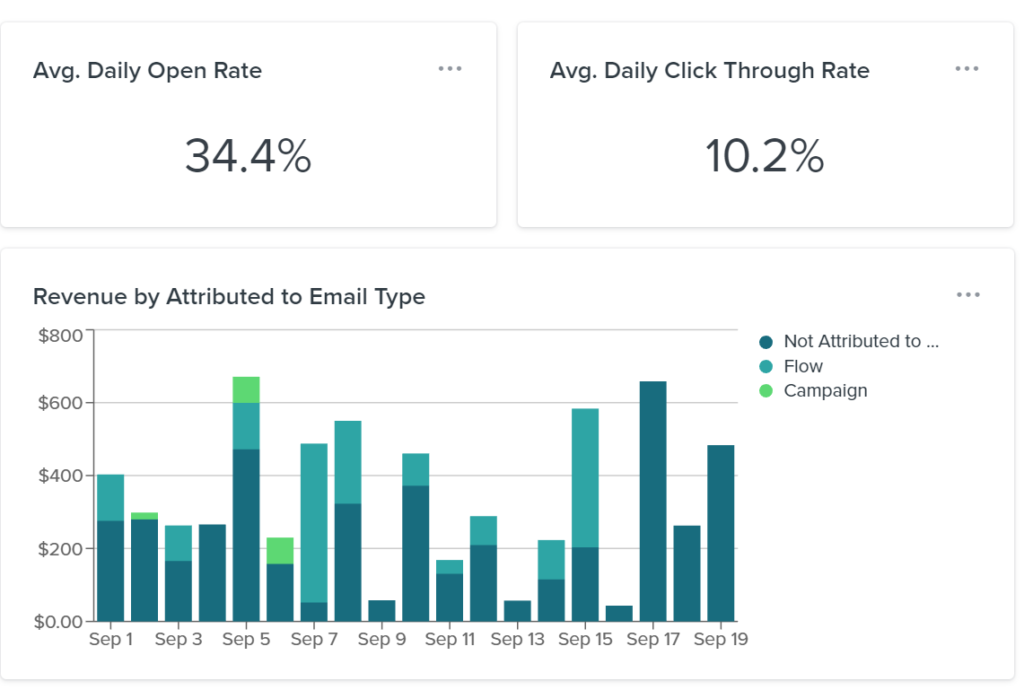
Klaviyo sports many customizable reports for any metric that you have data for.
Mailchimp’s options are more limited. there is no way to see what percentage of your shop’s sales are coming from email. You have to manually calculate it.
The Klaviyo dashboard shows all sales attributed to flows, separate from campaigns. Clicking into flows shows sales by specific email in the chain. You can select any timeframe to display sales.

How does this impact your business?
Clearly seeing the resulting opens, clicks, page views, sales and.. gasp.. unsubscribes from campaigns and automations is critical. It lets you see your ROI from email and lets you make informed decisions on your data.
From a CMO perspective, you can make better decisions on where your team should be allocating resources for the best return.
SMS + Other
While not technically email marketing, Klaviyo does have SMS campaign and automation features. Mailchimp does not have SMS marketing without installing a 3rd party integration.
Mailchimp has other nifty built-in features where you can advertise to your customers via postcard or retarget your subscribers with Facebook ads. You can also easily build and integrate landing pages. These options are not available without integrations on Klaviyo.
How does this impact your business?
SMS marketing has higher open and engagement rates and is a rapidly growing channel. Investing in SMS marketing now can give you company and edge over your competition and more sales for a low monthly investment.
Postcards, social ads and landing pages are nice addons to Mailchimp’s offerings and can generate extra revenue in a seamless way.
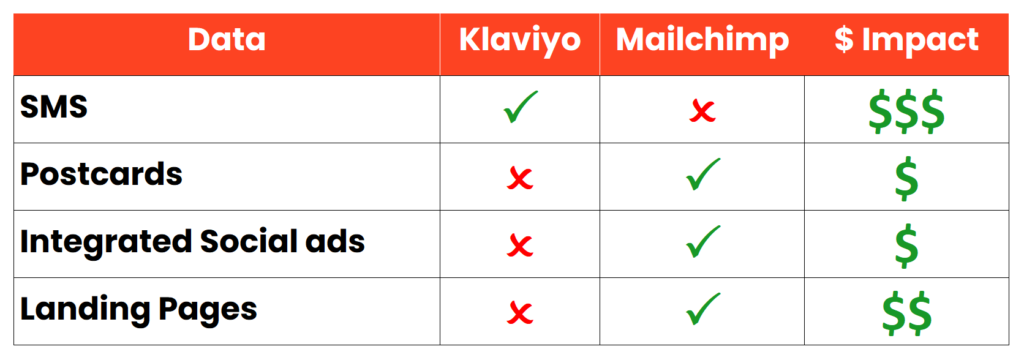
Ease of Use and Support
Both Klaviyo and Mailchimp have extensive knowledge bases, forums and customer support for their products.
Mailchimp support is tiered based on your plan, while Klaviyo’s isn’t. This means you may have to wait longer on lower Mailchimp plans to hear back from support on technical issues.
Each brand sports an easy to use campaign block builder. Mailchimp is easier to use. Klaviyo has more options, function and complexity, giving it a steeper learning curve.
How does this impact your business?
The basics of both platforms can be learned in a few hours. Setting up and learning Mailchimp is a smaller time commitment in the Klaviyo vs Mailchimp matchup.
But If you have an issue with your account, you might spend more time waiting on a reply from support if you have a lower end Mailchimp plan.
Pricing
Both Mailchimp and Klaviyo offer free accounts and both limit the number of emails that you can send monthly without incurring extra fees.
Klaviyo does not limit the features of the platform based on your plan while Mailchimp has different tiers. If you must have features that are only in the premium Mailchimp plan, it can make Mailchimp more expensive than Klaviyo.
One big beef I have with Klaviyo is that they don’t automatically ‘downgrade’ your plan if you send fewer emails one month. You have to manually make this change in your account.
On the flip side – they do automatically ‘upgrade’ your account and bill you more monthly if you send too many emails one month. Klaviyo should be more transparent here and have this work both ways.
Here is the pricing for 15K subscribers for Mailchimp:

Pricing for 15K subscribers on Mailchimp
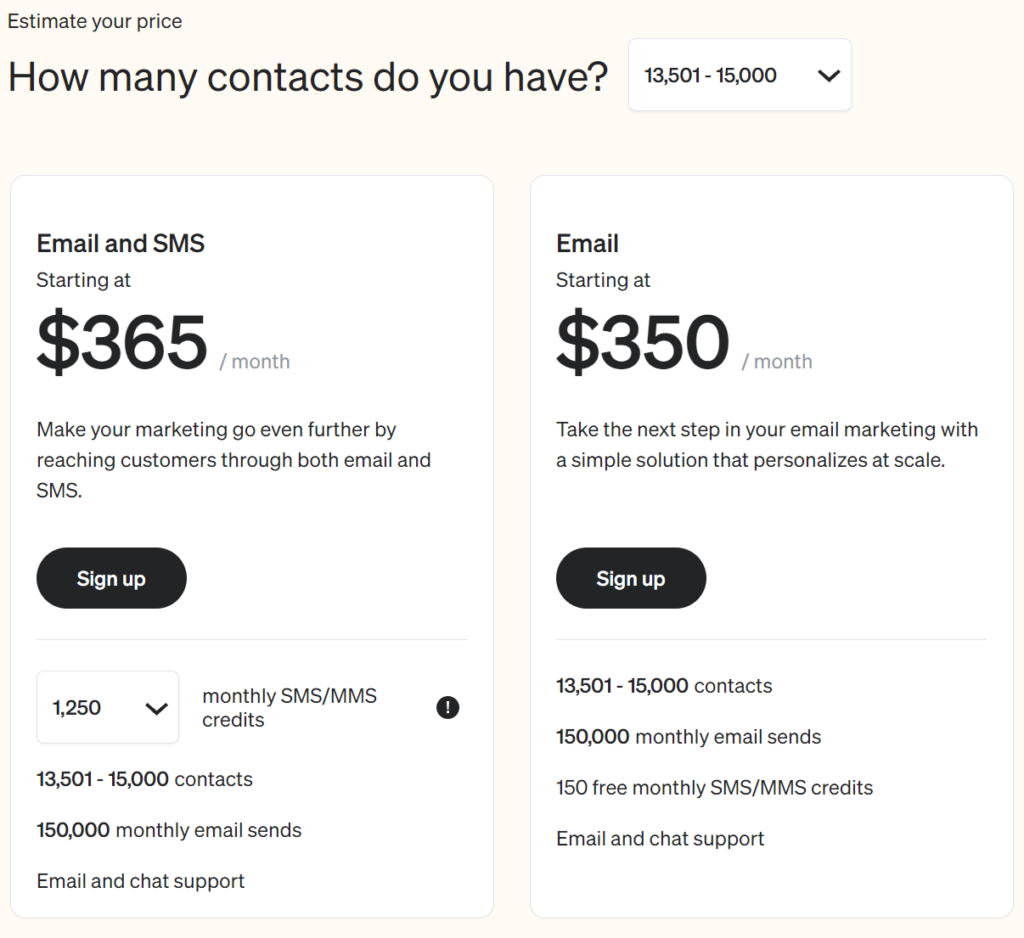
How does this impact your business?
You get what you pay for and Klaviyo is more expensive but has more features.
When comparing services in the Klaviyo vs Mailchimp matchup, it’s important to gauge how many campaign and automated emails you plan to send monthly. This way you can get the true monthly investment for each platform.
Be careful as both platforms have ways of inflating your ‘subscriber count’ leading to more monthly fees.
If someone enters their email on your website, but doesn’t sign up for your newsletter, they count as a contact on Klaviyo and Mailchimp. Even though you can’t send most email marketing to them.
On Mailchimp, contacts that are in more than one audience are double counted toward your total.
Klaviyo vs Mailchimp – The Verdict
Mailchimp is great if you want an inexpensive way to blast out a newsletter. It’s also a good option for brands that are just getting started and don’t yet have big email lists or website traffic. It’s easier to use and costs less per month compared to Klaviyo.
For more mature ecommerce brands, Klaviyo will help you make more sales and is better in every area except price. If your brand has a sizeable email list or traffic, Klaviyo will often pay for itself many times over.
The good news is that brands can make the switch to Klaviyo no matter what software you were using before.
If you’d like to sign-up for Klaviyo on your own and get a free demo, then click here.
If you’d like help switching your brand to Klaviyo, click here to see if we’d be a good fit. We can get your brand up and running with Klaviyo in about two weeks.
If you’d like to learn more about Mailchimp, click here.
Want to learn more about email marketing? See our other articles here.
